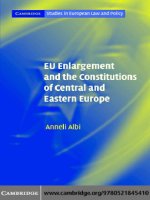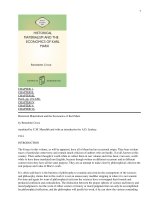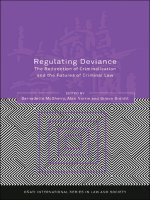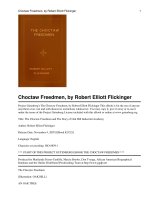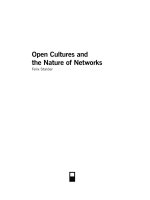dynamic antisymmetry and the syntax of noun incorporation
Bạn đang xem bản rút gọn của tài liệu. Xem và tải ngay bản đầy đủ của tài liệu tại đây (1.09 MB, 213 trang )
DYNAMIC ANTISYMMETRY AND THE SYNTAX OF NOUN
INCORPORATION
Studies in Natural Language and Linguistic Theory
VOLUME 84
Managing Editors
Marcel den Dikken, City University of New York
Liliane Haegeman, University of Ghent, Belgium
Joan Maling, Brandeis University
Editorial Board
Guglielmo Cinque, University of Venice
Carol Georgopoulos, University of Utah
Jane Grimshaw, Rutgers University
Michael Kenstowicz, Massachusetts Institute of Technology
Hilda Koopman, University of California, Los Angeles
Howard Lasnik, University of Maryland
Alec Marantz, Massachusetts Institute of Technology
John J. McCarthy, University of Massachusetts, Amherst
Ian Roberts, University of Cambridge
For further volumes:
/>DYNAMIC ANTISYMMETRY
AND THE SYNTAX OF NOUN
INCORPORATION
by
Michael Barrie
University of Ottawa, Ottawa, ON, Canada
123
Michael Barrie
University of Ottawa
Department of Linguistics
Arts Hall
70 Laurier Avenue East
K1N 6N5 Ottawa Ontario
Canada
ISSN 0924-4670
ISBN 978-94-007-1569-1 e-ISBN 978-94-007-1570-7
DOI 10.1007/978-94-007-1570-7
Springer Dordrecht Heidelberg London New York
Library of Congress Control Number: 2011929131
© Springer Science+Business Media B.V. 2011
No part of this work may be reproduced, stored in a retrieval system, or transmitted in any form or by
any means, electronic, mechanical, photocopying, microfilming, recording or otherwise, without written
permission from the Publisher, with the exception of any material supplied specifically for the purpose
of being entered and executed on a computer system, for exclusive use by the purchaser of the work.
Printed on acid-free paper
Springer is part of Springer Science+Business Media (www.springer.com)
Preface
This monograph is a revised version of my 2006 dissertation at the University of
Toronto. I have included more discussion on various issues in noun incorporation in
Northern Iroquoian languages based on changes in my understanding of the material
since 2006. I have also added additional material gathered during postdocs at the
University of British Columbia and the University of Ottawa. Much of the data
on Northern Iroquoian languages comes from my own fieldwork and from several
published sources. The system of interlinear glosses varies significantly from one
source to the next. For consistency, I have employed a uniform set of abbreviations
for the interlinear glosses throughout.
I wish to thank my consultants Daisy Elijah (Oneida), Nora Carrier and Gloria
Williams (Onondaga), Elizabeth Herrling (Halkomelem), and Beatrice Bullshields
(Blackfoot). Without their assistance, I would not have been able to undertake this
research. In addition, I wish to thank several colleagues of mine for their assis-
tance with the relevant literature and/or data including Diane Massam (Niuean),
Arsalan Khanemuyiour, Jila Ghomeshi, and Nick Pendar (Persian), Bettina Spreng
and Martina Wiltschko (German), Will Seto, Lisa Seto and Max Mak (Cantonese),
Yosuke Sato (Japanese), and Martina Wiltschko (Halkomelem).
Parts of this monograph have been presented at numerous conferences including
NELS35 and 36, the Linearization workshop at DGfS in 2010, the annual meetings
of the Canadian Linguistic Association and the Linguistic Society of America, and
the Workshop on Structure and Constituency in Languages of the Americas. I wish
to thank the audiences there for insightful questions and suggestions that led me to
revise and, hopefully, improve upon the details.
Numerous people have listened to me talk about my ideas presented here or
have collaborated with me on related projects, and have given useful and sub-
stantial feedback, or have simply asked vital, thought-provoking questions that
allowed me to improve my analysis. This list includes (in no particular order)
Elizabeth Cowper, Diane Massam, Alana Johns, Carrie Dyck, Martina Wiltschko,
Gabriela Alboiu, Éric Mathieu, Joel Dunham, Bettina Spreng, Heather Bliss,
Arsalan Khanemuyipour, Jila Ghomeshi, Kenji Oda, Yosuke Sato, plus others I have
surely forgotten.
Finally, I wish to acknowledge the financial support of SSHRC doctoral and post-
doctoral fellowships and a Killam post-doctoral research fellowship.
v
Abbreviations
A absential
ABS absolutive
ACC accusative
AG agent
AGR agreement
APPL applicative
ART article
BEN benefactive
BPS Bare Phrase Structure
C common noun
CAUS causative
CIS cislocative
CL classifier
CMP completive
COLL collectivizer
CONT continuous
CORE determiner for core arguments (as opposed to oblique arguments)
CUC Canonical Use Constraint
DEG degree
DEM demonstrative
DR bivalent direct (indicates that the object is lower on the thematic
hierarchy than the subject)
DU dual
DUC dualic
DUR durative
EPEN epenthetic
ERG ergative
EXCL exclusive
EZ ezafe vowel in Persian
F feminine
FACT factual mood
FUT future
vii
viii Abbreviations
GEN genitive
GER gerund
HAB habitual
INANIM inanimate
INC incompletive
INCL inclusive
IND indicative
INF infinitive
INSTR instrumental
INTR intransitive
INVIS invisible
ITER iterative
I.TH intransitive theme
JOIN joiner vowel, an epenthetic vowel in Northern Iroquoian languages
LCA Linear Correspondence Axiom
LF logical form
LNK linker vowel
LOC local
M masculine
M/A mode-aspect
N.CL noun class
NE a particle in Northern Iroquoian languages of unclear function
NEG negative
N/F neuter/feminine
NFS noun forming suffix
NI noun incorporation
NOM nominative
NT neuter
NZLR nominalizer
OBJCL object clitic
OBL oblique
OBV obviative
OPT optative
P proper noun
PART participle
PAT patient
PF phonetic form
PL plural
POSS possessive
PRED predicative marker
PRF perfect
PRFV perfective
PROG progressive
PROX proximate
PSR possessor
Abbreviations ix
PST past tense
PUNC punctual aspect
PURP purposive
Q question particle
REAL realis
REFL reflexive
REL relativizer
SBJV subjunctive
SG singular
SRFL semi-reflexive
STAT stative
TH theme vowel (indicates argument hierarchy relations in Algonquian
languages)
TNS tense
TR transitive
UG Universal Grammar
VCL verbal classifier
VTA verb transitive inanimate
This is Blank Page Integra x
Contents
1 Introduction 1
1.1 OutlookandGoals 2
1.2 Noun Incorporation . . 5
1.2.1 Properties of NI 5
1.2.2 On the Syntactic Nature of NI . . 8
1.3 Conclusion and Outline of Book 18
References 19
2 Theoretical Background 23
2.1 ABitofHistoryofPhraseStructure 23
2.2 BarePhraseStructure 26
2.3 Antisymmetry 30
2.4 HeadMovement 34
2.5 Alternative Accounts of Linearization . . 40
2.5.1 Demerge and Concatenate: SOV as Underlying Order . . . 41
2.5.2 ParameterizedOrder 42
2.5.3 Departures from the LCA 47
2.6 Conclusion . 48
References 48
3 Unifying Antisymmetry and Bare Phrase Structure 53
3.1 TheProblemofMutualC-Command 53
3.2 Previous Accounts . . 54
3.2.1 Guimarães (2000) and Self-Merge 57
3.2.2 Nunes and Uriagereka (2000) . . . 60
3.2.3 Richards (2001) 61
3.2.4 Conclusion . . 61
3.3 TheLCAandBPS 61
3.4 Proposal . . . 71
3.5 Alternatives to Complement-to-Spec Roll-Up . . . 77
3.5.1 Spec-To-Spec Movement and Romance Clitics . . . 78
3.5.2 Avoidance of the Initial Merger Problem . . 81
xi
xii Contents
3.6 Linearization and Late Insertion 85
3.7 Summary 88
References 88
4 Noun Incorporation in Northern Iroquoian 93
4.1 Northern Iroquoian Languages . 93
4.1.1 Clause Structure of Northern Iroquoian . . . 94
4.1.2 Nominal Structure in Northern Iroquoian . . 97
4.2 Patterns of NI in Northern Iroquoian . . . 100
4.2.1 Productivity of NI 101
4.2.2 NominalRoots 106
4.3 Analysis 107
4.3.1 PreviousAnalyses 107
4.3.2 NIasPhrasalMovement 112
4.4 Properties of Iroquoian NI . . . 118
4.4.1 NIinDitransitives 118
4.4.2 NIandOvertDPs 121
4.5 Conclusion . 123
References 123
5 Noun Incorporation and Its Kind in Other Languages 127
5.1 TheStructureofNominalsandV/INOrder 127
5.2 NI in Sierra Popoluca . 130
5.3 English Gerunds 132
5.3.1 Description of NI in English Gerunds . . . 133
5.3.2 Analysis 135
5.4 GermanProgressives 138
5.5 Persian‘LongInfinitive’Constructions 143
5.6 Tamil Noun Incorporation and Coordination 147
5.7 Adverb Incorporation in Blackfoot 150
5.8 Conclusion . 154
References 155
6 V+N Order 159
6.1 Polynesian Pseudo Noun Incorporation . . 160
6.1.1 The Structure of Niuean Nominals 161
6.1.2 Pseudo Noun Incorporation 163
6.1.3 Postlude on Tukang Besi Object Incorporation . . . 165
6.2 Romance Compounds . 167
6.2.1 Description of V+N Compounds . 168
6.2.2 Analysis of Romance Compounds 170
6.3 Mapudungun 172
6.4 UpriverHalkomelem 176
6.5 Conclusion . 181
References 183
Contents xiii
7 Conclusion 185
7.1 Summary 185
7.2 Limitations 186
7.3 Conclusions and Implications . . 190
References 194
Index 197
Chapter 1
Introduction
This monograph is a study of Noun Incorporation (NI) within the framework of
Dynamic Antisymmetry. It deals primarily with NI in Northern Iroquoian (repre-
sented principally by Oneida and Onondaga, with some discussion on Mohawk);
however, I also consider a number of other cases of NI and related phenomena in
a variety of languages. I propose that NI is the direct result of the need to satisfy
the Linear Correspondence Axiom (LCA). NI arises when the verb selects a bare
nominal root as a complement, thereby creating a point of symmetric c-command.
This point of symmetry is resolved by the nominal root raising to the specifier of VP.
My account is couched within two recent, well-received proposals on phrase struc-
ture, which I meld into a single cohesive framework. Specifically, I examine Bare
Phrase Structure (BPS) (Chomsky 1994) and Antisymmetry (Kayne 1994) and pro-
pose that the insights of both proposals can be maintained if we adopt a Dynamic
Antisymmetric view as proposed by Moro (2000; 2004). Moro proposes that move-
ment is driven by the need to satisfy the LCA, and furthermore that this movement
takes place overtly. Thus, if two terms cannot be linearized because of their non-
compliance with the LCA, something must move so that the LCA is satisfied. In
particular, I examine the case of two symmetrically c-commanding heads; a situa-
tion that arises upon the initial merger of two heads (the Initial Merger Problem).
This is precisely the situation in the case of NI as just described above. Thus, NI
is purely a result of the phrase structural properties of the VP. This eliminates
the need for a macroparametric mechanism, such as the Morphological Vi sibility
Condition (Baker 1996). I will also show that not only does an LCA violation (in
particular, symmetric c-command) trigger movement, it can also trigger a cascade of
movements often referred to as Complement-to-spec roll-up in the literature.
1
This
approach predicts that NI should typically appear with N+V order. Indeed, this order
is significantly more common than V+N order (Caballero et al. 2008); however, it is
by no means universal, as there are numerous counter-examples. I discuss how NI
with V+N order arises in later chapters.
1
These will come up later in the discussion where appropriate. Representative examples include
snowballing (Aboh 2004a)andintraposition movement (Rackowski and Travis 2000).
1
M. Barrie, Dynamic Antisymmetry and the Syntax of Noun Incorporation, Studies
in Natural Language and Linguistic Theory 84, DOI 10.1007/978-94-007-1570-7_1,
C
Springer Science+Business Media B.V. 2011
2 1 Introduction
The remainder of this chapter is structured as follows. Section 1.1 presents the
major goals of this monograph and gives a brief overview of how these goals will be
accomplished. Section 1.2 introduces the phenomenon of NI and presents its prop-
erties that are pertinent to the discussion. Section 1.3 is an outline of the remainder
of the monograph.
1.1 Outlook and Goals
I identify the following goals of this monograph:
• to present a thorough analysis of NI in Northern Iroquoian,
• to recast (Dynamic) Antisymmetry in a BPS framework,
• to argue for a Dynamic Antisymmetric analysis of NI, and
• to illustrate the Dynamic Antisymmetric analysis of NI with data from a variety
of other languages.
In regards to the first goal I describe in detail the various properties of NI that are
particular to Northern Iroquoian and show how the proposed analysis for NI coupled
with an innovative structure for the doubling construction accounts for the specific
properties of NI in this language group. A general description of NI is found in the
following section; however, I also discuss several additional properties of NI found
in Northern Iroquoian. Specifically, I discuss the kinds of nominals that can undergo
NI and their morphological properties. I also discuss how NI in Northern Iroquoian
interacts with wh-movement. In short, an in depth description of NI in Northern
Iroquoian is presented along with the general properties of NI cross-linguistically.
The facts presented here are based on a vast descriptive (Lounsbury 1949, 1953;
Froman et al. 2002; Woodbury 1975b, 1975a, 2003; Michelson and Doxtator 2002;
Bonvillain 1972) and theoretical (Michelson 1991; Baker 1988, 1996; Postal 1979)
literature on this topic, as well as various field trips conducted from 2003 to 2005
on Oneida and 2005 to the present on Onondaga. The discussion on the general
properties of NI is based on various cross-linguistic surveys on the topic (Mithun
1984; Caballero et al. 2008; Gerdts 1998; Massam 2009).
Accommodating Antisymmetry and BPS in a unified framework is not a straight-
forward task. I review and build on previous work on this topic (Guimarães 2000;
Oishi 2003; Richards 2001a; Uriagereka 1999; Kayne 2009a) and adapt a version of
the LCA that is compatible with the machinery of BPS. This comprises the bulk of
Chapter 3. Briefly, BPS requires the initial merger to be between two heads, giving
rise to a violation of the LCA as mentioned above. To resolve this violation, the
selected head raises to the s pecifier of the selector. The next head that this com-
plex merges with, however, will be in a symmetric c-command relation with the
head in specifier from the previous step, triggering another round of raising to sat-
isfy the LCA. This process sets off a cascade of roll-up type movement referred to
1.1 Outlook and Goals 3
above. Of course, the derivation does not continue this way indefinitely. I resolve
this situation by making the LCA sensitive only to heads with phonological content,
as suggested by Moro (2000). Thus, a phonologically empty head halts this type of
movement. I suggest that NI in particular highlights this fact about BPS and initial
merge since it typically involves merger of two lexical heads, hence two heads with
phonological content. Non-NI constructions involve initial merge between a lexi-
cal head and a functional head or between two functional heads – both situations
of which involve the possibility of a phonologically null head, thus obscuring the
Initial Merger Problem.
I now discuss briefly how the current proposal captures the fact that a full DP
complement to a verb and a bare noun
2
complement to a verb often exhibit different
linearization properties. The proposed analysis accounts for this asymmetry. When
the verbal root, V, selects a full DP as a complement, V asymmetrically c-commands
the material inside the DP in compliance with the LCA. When the V selects a bare
nominal root as a complement, the two elements c-command each other, in viola-
tion of the LCA. Following Moro’s Dynamic Antisymmetry (2000), the nominal
root raises to SpecVP to satisfy the LCA. By contrast, when V selects a full DP as
a complement, the verb asymmetrically c-commands the material inside the DP. In
the extended nominal projection alone a number of functional projections have been
identified with syntactic and semantic effects (Ritter 1992, 1993; Szabolcsi 1983;
Abney 1987; Cheng and Sybesma 1999; Ghomeshi 2003; Megerdoomian 2008);
however, whether the head is overtly realized with a particular morpheme is sub-
ject to a great deal of cross-linguistic variation, and many heads are phonologically
empty. This gives rise to a great deal of variation in the surface realization of the
morpheme order of DPs. In any event, when the verb selects a full DP comple-
ment, in the vast majority of cases, the verb will asymmetrically c-command all the
material inside the DP.
As already stated, the empirical foundation for this study consists of NI and
related phenomena. I offer an extensive discussion and analysis of NI in Northern
Iroquoian in Chapter 4, and I discuss similar facts in a variety of other languages
in Chapters 5 and 6. In the following examples, the verbs are shown in boldface
and the complement nouns are italicized to show their relative positions. The (a)
examples contain full DP complements and the (b) examples contain nominal com-
plements that have undergone NI or a closely related phenomenon, which I later
argue to be essentially the same as NI. Again, notice that the NI forms appear
with the order N+V (V+N is discussed in Chapter 6), while the order of V and
DP varies.
2
Throughout this monograph, I use the term bare noun to mean functionally bare (i.e., a bare root
or a bare nP), rather than morphologically bare in the sense of Giorgi and Longobardi (1991). This
distinction is important because a morphologically bare noun in this other sense could contain a
large number of functional projections with phonologically empty heads.
4 1 Introduction
1. NI in Onondaga (Northern Iroquoian)
a. wahahní:no˛
T
ne
T
ganakda
T
wa
T
-ha-hnino˛-
T
ne
T
ka-nakt-a
T
FACT-3. SG.M.AG-buy-make-PUNC NE AGR-bed-NFS
‘I’m making a house for him.’
b. wahanakdahní:no˛
T
wa
T
- ha- nakt- a- hnino˛-
T
FACT-3.SG.M.AG bed JOIN buy PUNC
‘He bought a bed.’
2. NI in English Gerunds
a. Alice enjoys collecting stamps.
b. Alice enjoys stamp-collecting.
3. German Progressives
3,4
a. Ich esse die Äpfel.
I eat.1.
SG the apple.PL
‘I’m eating the apples.’
b. Ich bin beim Äpfel- essen.
I am at.the apple.
PL- eat.INF
‘I’m eating apples.’ / ‘I’m busy apple-eating.’
4. Persian Long Infinitives
5
a.
sima æz xundæn-e in ketab xoš-eš mi-yad
Sima from reading-
EZ this book good-3SG CONT-come.3SG
‘Sima likes reading this book.’
b.
sima æz ketab xundæn xoš-eš mi-yad
Sima from book reading good-3
SG CONT-come.3SG
‘Sima likes reading books.’
In English, example 2, full DP complements appear to the right of the verb, and
what is demonstrably a bare noun appears to the left of the gerundive form of the
verb. Gerunds are taken up in more detail in Chapter 5. These data highlight the
asymmetry between full DP objects and bare noun objects. Specifically, whether
3
Of course OV word order is possible with full DP objects, as German is an SOV language. The
point here is that full DP objects can appear in either VO or OV word order, depending on whether
the verb appears in 2nd position or sentence-finally. With bare nominal objects as in the progressive
beim construction, only OV word order is found.
4
Unless otherwise stated, all German data are from Bettina Spreng and Martina Wiltschko
(personal communication).
5
Unless otherwise stated, all Persian data are provided by Jila Ghomeshi, Arsalan Kahnemuyipour,
and Nick Pendar (personal communication).
1.2 Noun Incorporation 5
the object appears before or after the verb depends on whether the object is a full
DP or bare noun. Of course, other factors may affect VO versus OV word order
(see footnote 3), but the generalization still holds. The theory of phrase structure I
advocate here accounts for this asymmetry in a s traightforward way.
There are, of course, instances of NI with the order V+N. I examine sev-
eral particular cases in detail in Chapter 6: pseudo noun incorporation (PNI) in
Niuean (Massam 2001), V+N compounds in Romance (such as Spanish toca-discos
‘record-player’ and French tranche-oeufs ‘egg slicer’), lexical suffixation in Upriver
Halkomelem, and NI in Mapudungun. I argue that V+N order results from the pres-
ence of additional functional material in the IN that permits the LCA to linearize the
verbal root with the elements inside the IN. Thus, no movement needs to take place
and the order V+N surfaces.
The major scientific contribution of this proposal is twofold. First, it accounts for
the robust cross-linguistic generalization that when a verb takes a bare noun as a
complement, we observe the order N+V more frequently than V+N (Caballero et al.
2008), and when the verb takes a full DP complement, we get roughly a 50–50 split
between the orders V+DP and DP+V (Ruhlen 1975; Dryer 2008). In Chapter 2,
I address the lack of a universal N+V order in NI constructions. Second, NI and
a wide range of related phenomena fall out naturally from the theory of lineariza-
tion proposed here. I do not need to posit any new syntactic mechanisms, so NI
comes for free, in effect. As a consequence, we do not need a variety of differ-
ent mechanisms to account for the phenomena in 2–4. Thus, rather than having to
posit different mechanisms to account for NI and related phenomena, I propose that
existing mechanisms accomplish this task.
1.2 Noun Incorporation
NI has been the subject of study for well over 100 years now (Kleinschmidt 1852;
Cuoq 1866; Kroeber 1909; Sapir 1911). It in fact continues to be the subject of
much heated debate and controversy, especially concerning its status as a syntac-
tic, morphological or lexical phenomenon (Baker 1996; Baker et al. 2005; Mithun
1984, 1986b; Sadock 1980, 1986; Rosen 1989). The works of several authors (prin-
cipally those in the references just mentioned) have converged on a common set of
prototypical properties of NI, which I describe below. I also discuss the typologi-
cal work of Caballero et al. (2008), which describes in detail those properties of NI
concerning the order between the IN and the verbal root.
1.2.1 Properties of NI
Northern Iroquoian languages illustrate many prototypical properties of NI (Rice
1991; Baker 1988, 1996; Mithun 1984; Woodbury 1975b), which are described in
depth in Chapter 2 and are analyzed in Chapter 3. These include: (i) the ability to
incorporate a direct object, instrument, path or subject of an unaccusative, but not an
6 1 Introduction
indirect object, goal, source, comitative or subject (example 5, Mohawk, and exam-
ple 6, Onondaga),
6
(ii) the ability for the incorporated noun to appear with a full DP
double or modifier (examples 7–8, Onondaga), (iii) the surface order N+V (observed
throughout, though see t he forthcoming discussion on order in the following para-
graphs), (iv) the optionality of NI (example 9, Oneida), (v) frozen scope (observed
in 10), and (vi) idiomatic meanings. I will show that properties (i) and (iii) boil down
to a situation of symmetric c-command triggering NI via movement. Properties (ii)
and (iv) are related to the structure for NI I propose in Chapter 3. These are illus-
trated in the following examples. Note that the properties illustrated below apply
generally to all Northern Iroquoian languages (Baker 1988, 1996; Bonvillain 1972;
Woodbury 1975b, 1975a; Mithun 1984; Abbott 2000;Fromanetal.2002).
5. NI in Mohawk Ditransitives (Baker 1996: 207)
a. t-a’- khey- athvni- tsher- u- ’ ne owira’a
CIS- FACT-1.SG.AG:3.SG.F.PAT -ball- NZLR-give-PUNC NE baby
‘I gave the ball to the baby.’
b. # t- a’- ke- wir- u- ’ ne athvno
CIS- FACT-1.SG.AG- baby- give- PUNC NE ball
‘I gave the baby to the ball.’ (NOT ‘I gave the ball to the baby.’)
6. a. honathahidákhe
T
(Woodbury, 2003: 282)
hon- at- hah- itakhe-
T
3. PL.M.PAT- SRFL- path- run- PURP
‘They are walking on a path.’
b. wa
T
hage
T
nhyayé˛hda
T
(Woodbury, 2003: 928)
wa
T
- hak-
T
nhya- a- ye˛hd- da
T
FACT-3.SG.M.AG :1.SG.PAT stick- JOIN-hit- PUNC
‘He hit me with a stick.’
c. ohahaná:we˛h (Nora Carrier, Gloria Williams, speakers)
o- ahah- a- nawe˛- h
3.
SG.NT.PAT- road- JOIN-wet- STAT
‘The road is wet.’
7. wa
T
gnasgwohae
T
ne
T
gwísgwis (ibid.)
wa
T
- k- naskw- ohae-
T
ne
T
kwiskwis
FACT -1.SG.AG- animal- wash- PUNC NE pig
‘I washed the pig.’
6
See Öztürk (2009) and Cagri (2009), however, for discussions on so-called subject incorporation
inTurkishaswellasPolinsky(1990) for subject incorporation in Chukchi.
1.2 Noun Incorporation 7
8. a. wa
T
khní:no˛
T
ne
T
ne˛ge
T
ganakda
T
(ibid.)
wa
T
- k- hnino˛-
T
ne
T
ne˛ke
T
kanakta
T
FACT -1.SG.AG buy- PUNC NE DEM bed
‘I bought this bed.’
b. wa
T
gnakdahní:no˛
T
ne
T
ne˛ge
T
(ibid.)
wa
T
- k- nakt- a- hnino˛-
T
ne
T
ne˛ke
T
FACT -1.SG.AG- bed - JOIN-buy- PUNC NE DEM
‘I bought this bed.’
9. NI in Oneida (Daisy Elijah, speaker)
a. waPkhni:nú: ká:sleht
waP-k-hninu-´: ka-Psleht-Ø
FACT -1.SG.AG-buy- PUNC 3.SG.NT-car-NFS
‘I bought a car.’
b. waPkePslehtahni:nú:
waP-k- e- Psleht- a- hninu- ´:
FACT -1.SG.AG- JOIN- car- JOIN-buy- PUNC
‘I bought a car.’
10. Yah te-wake-nakt-a-hninu
No
NEG-1.SG.PAT-bed-EPEN-buy. STAT
‘I didn’t buy the bed.’ Or ‘I didn’t buy a(ny) bed.’
=‘There is a bed that I didn’t buy.’ (Baker, 2003: 116)
11. e˛dyo˛dwe˛nage˛
T
sä:hgwa
T
(Onondaga, Gloria Williams and
e˛-d-yo˛-ad-we˛n-a-ge˛
T
sR-hgw-a
T
Nora Carrier, speakers)
FUT-DUC-3.SG .F.AG -SRFL-word-EPEN-rest/pillow-INSTR-PUNC
‘They put it under a pillow’ / ‘They tabled the matter.’
Example 5 shows a ditransitive, in which the direct object, but not the indirect object,
can undergo NI. Example 6 shows NI of a path, an instrument and an unaccusative
subject. Example 7 illustrates doubling of the IN (animal) with a hyponymous
object (pig). Example 8 shows a stranded modifier (a demonstrative).
7
Example
9 shows that NI is optional in Oneida. Example 10 shows that the IN in Mohawk
exhibits frozen scope with respect to a scope bearing element outside the verbal
complex. Finally, example 11 shows that NI often gives rise to idiomatic readings.
Mithun (1984) also observes that NI constructions are often used in institutional-
ized activities and are sometimes restricted to particular kinds of uses. This is akin
7
Theuseofthelabelmodifier stranding to describe example 8 has theoretical implications that I
discuss in greater detail in Chapter 4.
8 1 Introduction
to the Canonical Use Constraint (CUC) discussed by Kiparsky (1997). All of the
properties just discussed hold in Northern Iroquoian generally.
Perhaps unsurprisingly so, it will become clear throughout the discussion, espe-
cially in the later chapters, that not all languages with NI exhibit the exact same set
of properties for this phenomenon. The landmark discussion on the types of NI, its
discourse properties and effects on argument structure is Mithun (1984), a typology
which maintains widespread currency in the literature today.
I turn now to a discussion of the typological properties of NI as it relates to linear
order. Based on Kayne’s (1994) principle of Antisymmetry, Baker (1996) proposed
that NI is universally N+V – a claim he backed down on (Baker et al. 2005)in
light of the V+N order found in Mapudungun. Caballero et al. (2008) conducted
the first wide-scale cross-linguistic study on linear order in NI, where they show
that N+V order is significantly more prevalent in NI constructions than V+N order.
Note that OV and VO order (with full DP objects) is pretty much evenly distributed,
(Ruhlen 1975; Dryer 2008). Caballero et al. report the following results to their
study (adapted from source document).
12. N+V V+N Total
Productive
8
26 (67%) 13 (33%) 39
-OV 15 2 17
- VO 9 10 19
Non-productive 8 (100%) 0 (0%) 8
Total 36 (73%) 13 (27%) 49
As the reader can see, there is a distinct preference for N+V order; however, this
difference is more pronounced because of the instances of non-productive NI (i.e.,
where such forms are lexicalized). Nevertheless, there is still a significant preference
for N+V order in languages with productive NI.
9
1.2.2 On the Syntactic Nature of NI
I conclude this section with some arguments in favour of maintaining a syntactic
analysis of NI, in spite of various counter-arguments. I discuss the range of elements
that can be incorporated, idiomatic readings associated with NI constructions, and
frozen scope.
One argument against a syntactic treatment of NI lies in the fact that ele-
ments other than the direct object can be incorporated (Rosen 1989; Spencer 1995;
8
Not all languages with productive NI were classified as OV or VO languages, hence the
discrepancy in totals.
9
Note that I have nothing to say about the correlation between VO/OV order and V+N, N+V order
despite the fact that this is significant.
1.2 Noun Incorporation 9
Di Sciullo and Williams 1987). In particular, paths, locations, instruments and
adverbs can undergo NI (or adverb incorporation in the case of the latter), in several
languages, as discussed above. Excluded from NI constructions, however are goals,
benefactives, sources and comitatives. This seemingly disparate set of elements
(direct objects, paths, instruments, locations, and adverbs) is actually a natural class
under a Larsonian (1988; 2004) analysis of VP-internal elements. Under Larson’s
analysis, these elements are introduced in the specifier or complement of a VP
shell.
13.
VP
XP
V’
V
VP
XP
V’
V XP
Thus, when one of these elements is introduced as a bare root in complement posi-
tion, it undergoes NI the same way the direct object does. The other elements, goals,
sources, benefactives and comitatives, are introduced by functional projections of
various kinds, or, in the case of comitatives, involves some other constructions
altogether.
The inability for indirect objects to undergo NI has been noted in the literature
before (Mithun 1984; Baker 1996: 297ff.). The exact structure of ditransitives plays
an important role here. Pylkkänen (2008), for instance, has argued that goal argu-
ments are introduced by a low applicative head (see Larson 2010 for arguments
against this approach, though).
10
She also introduces other elements such as instru-
ments by applicative heads; thus, this approach fails to capture the natural class
described above. Larson’s (1988; 1990) original discussion of the double object
construction placed the indirect object and goal directly inside a VP shell, which
also fails to capture t he natural class described above. Baker (1988; 1996) argues
that the indirect object/goal/source is introduced in the VP shell by a phonologically
null preposition. Consider the following example (Baker 1996: 298).
10
Larson takes issue with the fact that Pylkkänen has divorced the goal argument from the event
semantics. Thus, in a construction such as John baked Mary a cake, Mary is related to the cake
by a to.the.possession.of predicate, but is not related to the event. Fatally, however, Larson argues
that this approach fails to capture the fact that the subject, John, must be responsible for Mary’s
receipt of the cake. Under Pylkkänen’s approach, the sentence above is compatible with a scenario
in which John baked a cake and someone else brought it to Mary. Since I do not ultimately adopt
Pylkkänen’s approach, I won’t pursue this line of reasoning further here.
10 1 Introduction
14.
VP
NP
V’
NV PP
ball give P NP
ØN
baby
Baker argues that the null preposition provides the semantic distinctions necessary
to encode direction in transfer of possession verbs (buy fr om vs. give to). Note that
indirect objects in Northern Iroquoian languages can be either sources or goals, so
the distinction must be encoded somewhere (see also Michelson 1991). Consider
the following Onondaga examples (Woodbury 2003).
15. a. wa
T
ho˛wahyahní:no˛
T
wa
T
-ho˛wa-ahy-a-hnino˛-
T
FACT -3.AG:3.SG.M.PA T-fruit-JOIN-buy-PUNC
‘Someone bought fruit from him.’
b. wa
T
khé:yo˛
T
wa
T
-khe-o˛ -
T
FACT-1.SG.AG:3.SG.F.PAT-give-PUNC
‘I gave it to her.’
It is not clear how Baker’s approach extends to paths, locations and instruments,
however. Under the approach above, a null P is necessary to give rise to the correct
semantics for the indirect object. Assumedly, a null P would be necessary to give rise
to the correct reading (instrumental, locative, etc.) to the relevant nominal phrase. It
would be unclear, then, what blocks incorporation of the indirect object, but allows
it for paths, locations and instruments.
Beck and Johnson (2004) also argue that indirect objects are introduced by a
functional projection based on its behaviour with the adverb again. Crucially, dou-
ble object constructions allow both a repetitive and restitutive reading with again.
Consider the following example, with the repetitive and restitutive readings spelled
out, respectively (Beck and Johnson 2004: 113).
16. Thilo gave Satoshi the map again.
17. a. Thilo gave Satoshi the map, and that had happened before.
b. Thilo gave Satoshi the map, and Satoshi had the map before.


